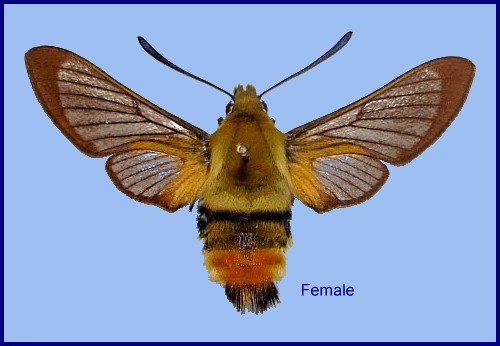UK: Levant Bee Hawkmoth
Hemaris (Mandarina) galunae Eitschberger, Müller & Kravchenko, 2005, Atalanta, Würzburg 36(1/2): 200.Type locality: Arne Valley, Mount Hermon, SW Syria, 1600m.
(Taxonomic note. Recent DNA barcoding studies indicate that Hemaris galunae is related to Hemaris aksana (Le Cerf, 1923) from the mountains of Morocco. The two species, which are related to Hemaris tityus (Linnaeus, 1758), appear to be the western and eastern remnants of a species which once occurred right across a cooler, greener and wetter North Africa during the last ice age.)
Holarctic; western Palaearctic region. Pleistocene refuge: Monocentric -- North African subsection of the Mediterranean refuge.

Wingspan: 44--51mm. Very similar to Hemaris tityus and the eastern palaearctic Hemaris radians (Walker, 1856), but with a broader marginal band on both forewing and hindwing. Extent of the light yellow scaling on the black scaling of the basal field and inner edge angle of hindwing upperside and underside intermediate between that of Hemaris tityus and Hemaris radians. Also similar to Hemaris aksana, but the green of the thorax is more yellowish. Abdominal tufts almost black with few light brown or light yellow hair-like scales, which are more strongly interspersed in Hemaris tityus and Hemaris radians. Antennae shorter and in the apical third somewhat broader than in Hemaris tityus, coming nearer to the condition in Hemaris radians.
Diurnal. A montane species of flower-rich meadows between 1200 and 1600m.
Late April to late May.
OVUM: Unknown.
LARVA: Unknown.
PUPA: Unknown.
None recorded.
So far, only known from western and northern Syria (Mount Hermon, 1600m; 12km southwest of Al Qamishli), and from near Navale (Mardin Province, 1250m) in southeastern Turkey (de Freina, 2012).
Extra-limital range. None.
None.
 Return to species list
Return to species list